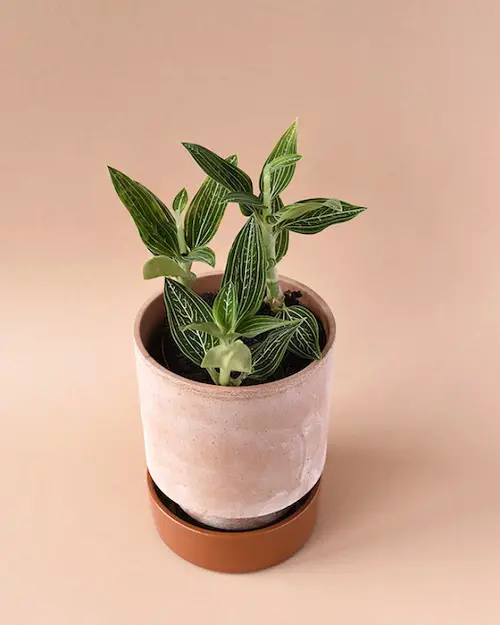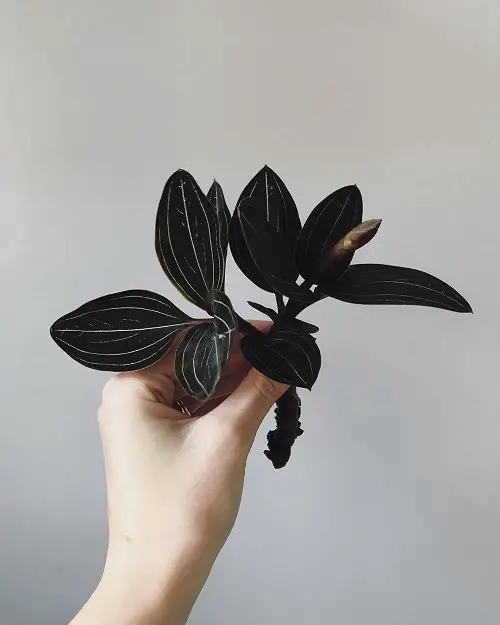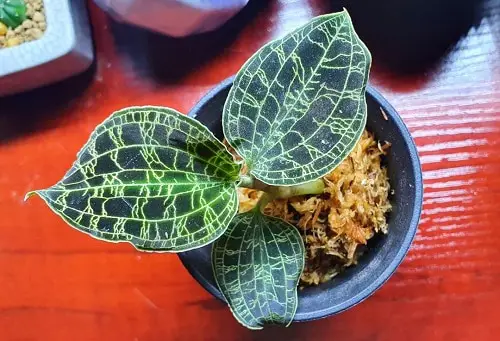Take the right Jewel Orchid Care to ensure it thrives with its patterned foliage and matching flowers for a long time to come!

Most Orchids are grown for their beautiful blooms. But, not Jewel Orchids, as they have stunning foliage to match with their flowers! If you too want it in your house, then here’s everything on Jewel Orchid Care.
Botanical Name: Ludisia discolor
Common Name: Jeweled Orchid
Check out our article on how to grow orchids here
Best Jeweled Orchid Varieties

- Ludisia discolor ‘Alba’ – It has deep green foliage with sparkling silver-white lines.
- Ludisia discolor var. nigrescens ‘Ambrosia’ – The velvety dark green leaves of this plant have a purple hue.
- Ludisia discolor var. ordiana – This looks a lot like ‘Alba.’ The only difference being it has little pronounced markings, and the leaves have a maroon hue underneath.
Propagating Jewel Orchid
As the stems of this plant are quite brittle and break easily, it is the best way to propagate this plant! Snip out a healthy stem, remove the bottom leaves and keep the upper ones intact. Dip the end in a rooting hormone and plant it in an orchid mix. It will develop roots in 1-2 months.
Growing Requirements of Jewel Orchid

Light
Jeweled Orchids are hidden under the forest canopy in their natural habitat and therefore do not need bright light. When growing them indoors, it is best to keep them at a spot where they get indirect light. Keeping the plant near a north-facing window would be ideal. When exposed to direct sunlight, the leaves can get burned and start to wilt.
Water
The plant does best in slightly moist soil. Ensure that you are never letting the soil go completely dry and are also not soaking it with water completely. The best rule of thumb is to keep an eye on the topsoil; if it feels a little dry to touch, water the plant.
We have a great article on how to water orchids the right way here
Soil
Use a classic orchid potting mix or make your own by mixing equal parts of peat moss, perlite, and potting soil. Since they are terrestrial plants, using just the potting soil won’t do.
Check out the best potting mix recipes for orchids here
Temperature and Humidity
This plant should not be near direct heat, or the leaf tips can burn. It does best in the daytime temperature of 70-80 F (21-26 C) with a nighttime temperature of 60-65 F (15-18 C). Ensure it is not exposed to a temperature below 55 F (12 C) as it can be harmful.
You don’t have to worry much about humidity with this Orchid. Just mist the foliage once in 2-3 days, and the plant will do just fine.
Jewel Orchid Care

Fertilizer
It is best to fertilize the plant once in 3-4 weeks with a balanced liquid fertilizer like 10-10-10. Dilute it with water to half or one-quarter of its strength. There are also specialized fertilizers available for orchids in the market. While using them, do make sure that you are referring to the label for dosage and instructions.
If you live in a cold climate, stop fertilizing during the dormant period in winter.
Re-potting
Re-pot the plant only if you notice it getting overcrowded and too top-heavy. It spreads wide and does not grow much tall, so you don’t have to use a very deep pot. Just go for one size bigger than the old one. While re-potting, always use a fresh potting mix.
Pests and Diseases
Watch out for pests like scale, aphids, or mealybugs. Remove them manually or use an insecticidal soap.
Watch out for any discolorations or falling leaves because this can be a sign of bad health. Remove them to eliminate the problem spreading to the entire plant.


